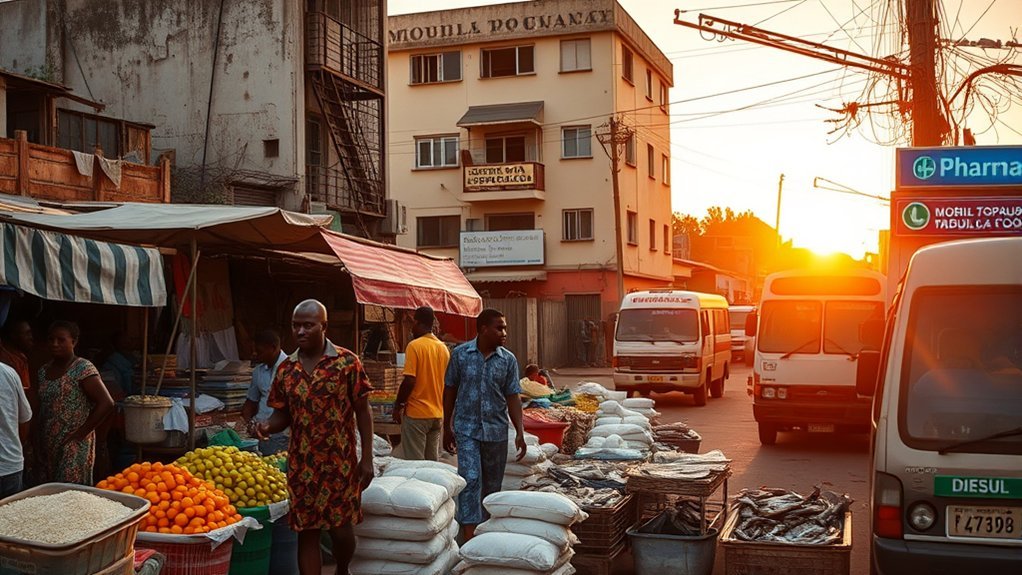You’ll typically need about $923 a month to live in Mozambique, well below many countries but still challenging given average take-home pay of ~$384. Rent for a one-bedroom city-center apartment runs near $467, utilities are modest, and groceries and transport are affordable compared with the U.S. Childcare, private schooling, and private healthcare can drive costs much higher, so policy gaps around wages, housing and subsidies matter — keep going to see detailed figures and implications.
Overview of Mozambique’s Cost of Living and Key Figures
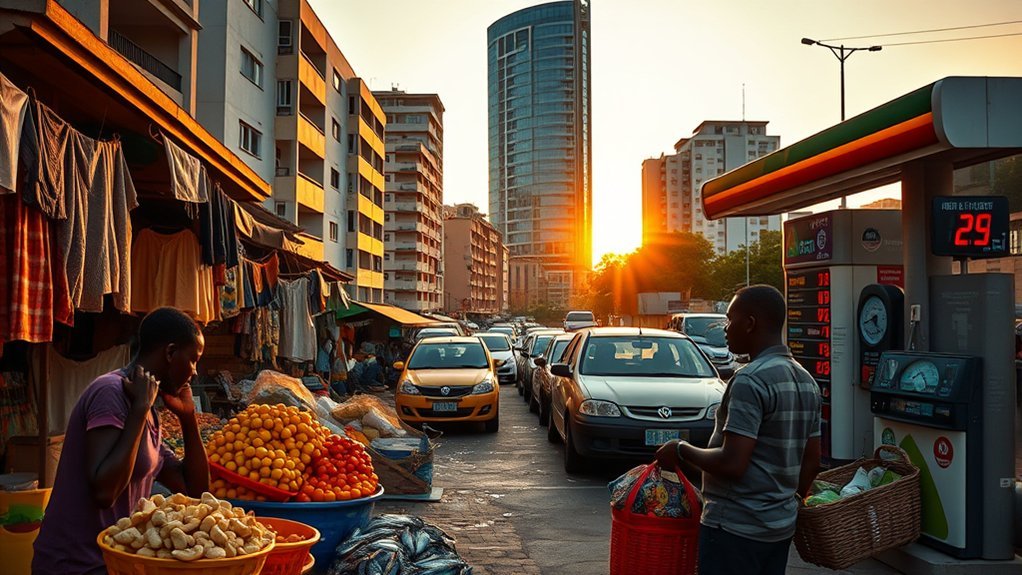
Although Mozambique is cheaper than many countries, you’ll still want to plan carefully: the average monthly cost of living is about $923, roughly 1.24 times lower than the global average, while average take-home pay sits at $384, ranking the country 105th of 197.
Mozambique is affordable but requires careful planning: monthly living costs ~$923 versus take-home pay ~$384, limiting purchasing power.
You should weigh that gap when evaluating purchasing power and budget policy implications. Key figures show a one-bedroom apartment in the city center averages $467 and a three-bedroom $861, compressing disposable income for households.
Utilities add modest overhead—about $51.4 monthly for an individual and $78.9 for a family—while eating out remains affordable (lunch ~$7.48, dinner for two ~$29.6).
From a policy perspective, social safety nets and wage growth matter: low salaries relative to cost of living suggest targeted interventions to boost income or subsidize essentials.
You’ll want to prioritize housing affordability, wage policies, and targeted subsidies to improve real living standards without stoking inflation.
Housing and Utilities: Rent, Buying, and Monthly Bills
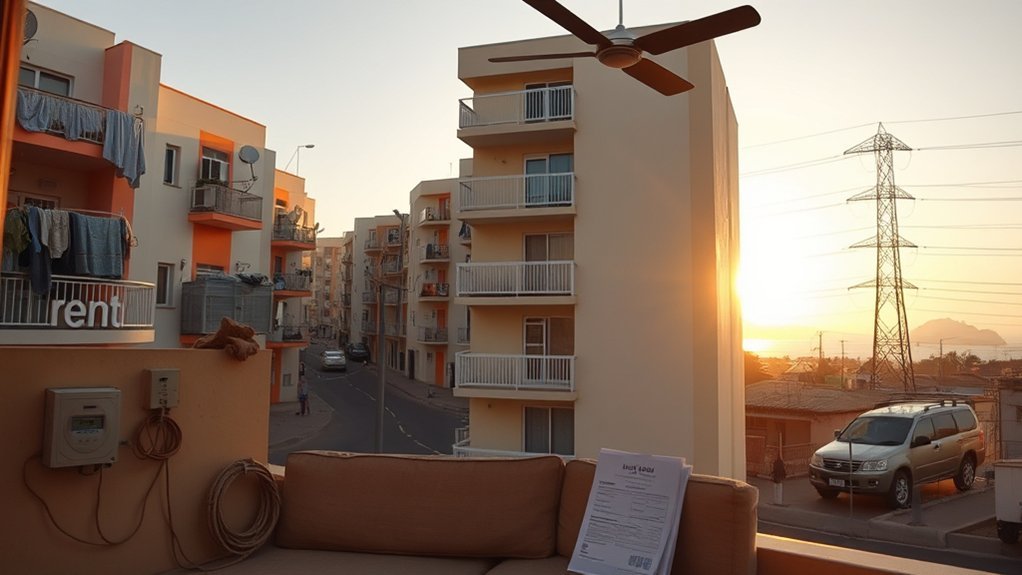
Having looked at income and overall living costs, it’s important to examine housing and utilities since they take up a large share of household budgets.
You’ll find rent for a 1-bedroom city-center apartment averages $467, while a 3-bedroom runs about $861; that’s roughly 89.0% cheaper than New York City, highlighting Mozambique’s affordability for urban renters. If you plan to buy, expect approximately $4,856 per square meter in the city center, a metric you’ll use when comparing long-term investment versus monthly rent payments.
Monthly utilities for an 85m² apartment average $51.4 for an individual and $78.9 for a family; include electricity, water and basic waste services in budgeting models.
High-quality internet (60 Mbps+) costs about $103/month, which can materially affect household service bills.
From a policy perspective, these figures suggest rental markets remain accessible but underline the need for targeted housing supply and infrastructure investment to improve affordability and resilience of utilities for growing urban populations.
Food and Dining: Groceries, Restaurants, and Local Prices

You’ll see that basic groceries are inexpensive in Mozambique — a liter of milk is about $1.58 and a loaf of bread around $0.77 — which affects household food budgets and subsidy considerations.
Eating out remains affordable too, with a lunch menu at roughly $7.48, a McDonald’s combo near $6.64, and dinner for two around $29.60, informing choices between home cooking and restaurant spending.
Local market finds like a 0.5L domestic beer at $1.18 and a cappuccino at $2.15 further highlight cost differentials compared with countries where restaurant prices average 2.7 times higher.
Grocery Prices Breakdown
Grocery shopping in Mozambique is markedly cheaper than in the United States, with staple items showing large price gaps that matter for budgeting and policy decisions.
You’ll find grocery prices roughly 2.3 times less expensive overall, which alters household expenditure patterns and social support needs. A loaf of bread costs about $0.77 versus $3.56 in the U.S.; a dozen eggs runs $2.58 compared with $4.27.
Protein costs also diverge: boneless chicken breast is roughly $1.96 per pound versus $5.41. Even small consumer goods differ—an 11 fl. oz Coca-Cola is $0.81 in Mozambique and $2.56 in the U.S.
Policymakers should weigh these differentials when designing wage floors, food assistance, and inflation monitoring.
Eating Out Costs
Prices at restaurants and cafés reinforce how far lower food costs in Mozambique can reshape household budgets and policy choices.
You’ll find lunch menus around $7.48 and dinner for two about $29.60, with fast-food meals at $6.64 and cappuccinos near $2.15. Domestic beer is particularly cheap at $1.18.
These figures show eating out costs are substantially below U.S. levels (basic meal ~$6.85 vs. $19.45), affecting disposable income and informal-sector demand.
For policy, that gap suggests interventions—like targeted subsidies or tourism pricing—will have asymmetric impacts across income groups.
If you budget for mid-range dining, estimated monthly costs for a family of four run about 3,250.00 MT, useful when modeling household consumption and fiscal measures.
Local Market Finds
Market signals show food and dining in Mozambique are markedly affordable: a mid-range dinner for two runs about 3,250 MT, a fast-food McMeal costs roughly 500 MT, and a 0.5L domestic draft beer averages 90 MT, while staple groceries—like a loaf of bread (~$0.77) and a dozen eggs (~$2.58)—keep basic household food bills low.
You’ll find local markets and supermarkets that let you optimize budgets; buying seasonal produce and staples at open-air stalls reduces unit costs and supports informal livelihoods.
For policy planning, prioritize improving market infrastructure, cold-chain service, and transparent price monitoring to stabilize access.
When comparing to the US, Mozambican dining delivers substantial purchasing-power advantages, but targeted interventions can further enhance food security and consumer protection.
Transportation and Commuting Costs
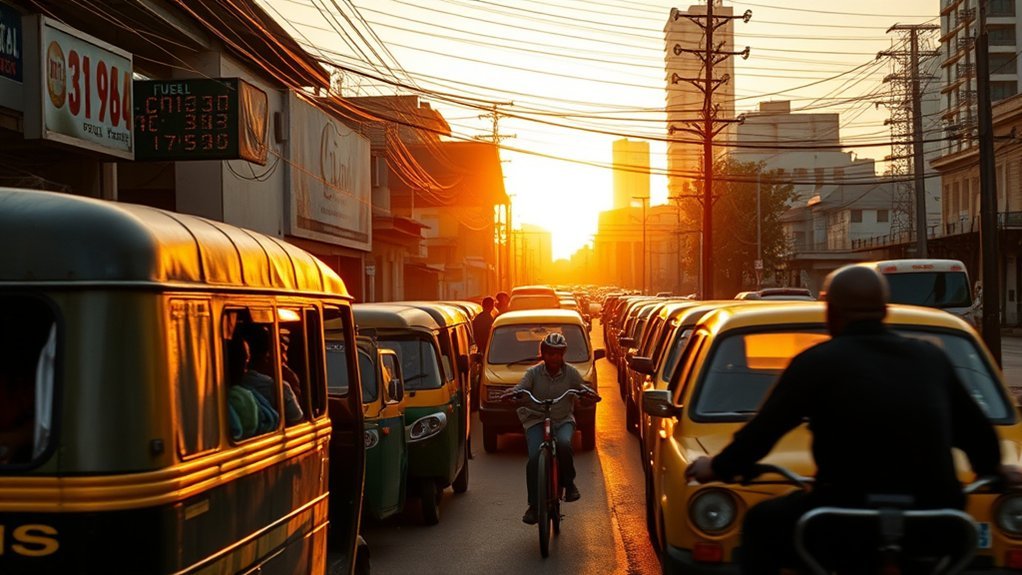
When planning your budget, compare public transport fares — a one-way ticket is about 22.50 MT and a monthly pass roughly 841.30 MT — to assess regular commuting costs.
Factor in taxi and ride-hailing rates, which start at 100 MT with about 106 MT per kilometer (an 8 km ride is roughly $17.40), so occasional trips can add up quickly.
Also consider fuel and vehicle costs, with gasoline near 86.40 MT per liter, to evaluate whether driving or using public transit is more cost-effective under local policy and infrastructure conditions.
Public Transport Fares
In urban Mozambique, public transport fares are low enough that many residents can rely on buses and minibus services for daily commuting: a single local trip costs about 22.5 MT (~$0.27) while a monthly pass runs roughly 841.3 MT (~$13.60), offering predictable, budget-friendly mobility options.
You’ll find public transport fares support affordability and social inclusion, reducing pressure on household budgets and encouraging modal shift from private cars.
For policymakers, subsidized or regulated local transport keeps urban labor markets accessible and limits congestion. Monitoring fare stability against fuel prices (about 86.4 MT/liter) and taxi tariffs is essential to avoid hidden cost escalation.
You should prioritize targeted subsidies, integrated ticketing, and service quality upgrades to sustain reliable, equitable urban mobility.
Taxi and Ride-Hailing
Public transport’s low fares make buses and minibuses the backbone of daily mobility, but many people still rely on taxis and ride-hailing for flexibility, longer trips, or when schedules don’t match their needs.
You’ll find taxi fares start at 100 MT (≈$1.40) with about 106 MT (≈$1.50) per additional kilometer; an 8 km ride costs roughly $17.40, illustrating private transport’s premium over public options.
Ride-hailing services mirror these market rates, offering convenience at higher cost. From a policy perspective, the gap between a one-way local ticket (~22.5 MT, $0.27) and private fares suggests subsidies or regulated fare structures could improve equity.
If you commute frequently, compare monthly transport passes (≈841.3 MT, $13.60) against regular taxi use.
Fuel and Vehicle Costs
One clear advantage for drivers is Mozambique’s relatively low gasoline price—about $1.18 per liter—which keeps operating costs down compared with many countries and alters the trade-off between owning a vehicle and relying on cheap public transport.
You’ll find fuel cheaper than in many markets, reducing per-kilometer costs and influencing policy debates on subsidies and infrastructure investment.
Still, transportation choices hinge on use patterns: a single local ticket at $0.27 or a monthly pass of $13.60 makes public transit extremely affordable for commuters, while an 8 km taxi at $17.40 is noticeably costlier.
If you’re planning household budgets or urban mobility policy, balance vehicle ownership savings against maintenance, parking, and road quality, plus incentives to strengthen public transport.
Childcare, Education, and Healthcare Expenses
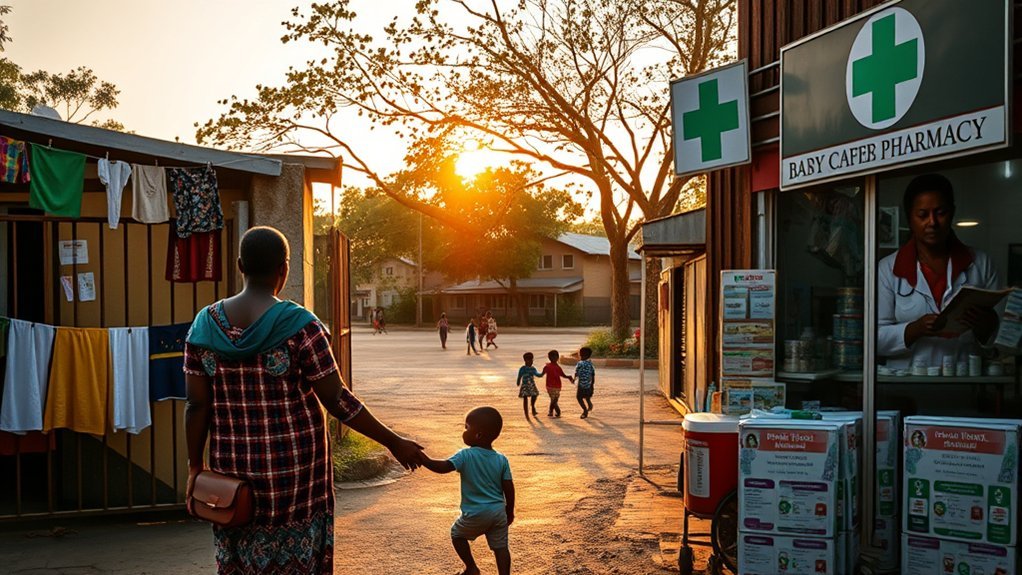
Because childcare and schooling costs can quickly outpace typical wages, you’ll want to plan carefully: full-day private preschool runs about 9,200 MT per month per child while international primary tuition averages roughly 370,000 MT per year, compared with an average net monthly salary near 27,917 MT.
Childcare and schooling can rapidly exceed typical wages—plan carefully around steep preschool and international school costs.
You should budget childcare and education as priority household expenses, since private options consume a large share of income for local families and expatriates alike. Researching institutions matters: fees vary by services, curriculum, and location.
Policy-wise, limited public international-standard options push demand toward costly private schools, affecting workforce mobility for skilled workers. Healthcare spending is similarly sensitive to income and service level; private clinics and insurance reduce risks but increase recurring costs.
If you’re relocating, compare total annual education plus healthcare costs to net household income, evaluate employer support or subsidies, and consider local versus international schooling trade-offs. That approach helps align family needs with realistic fiscal planning.
How Mozambique Compares to the United States and Other Countries
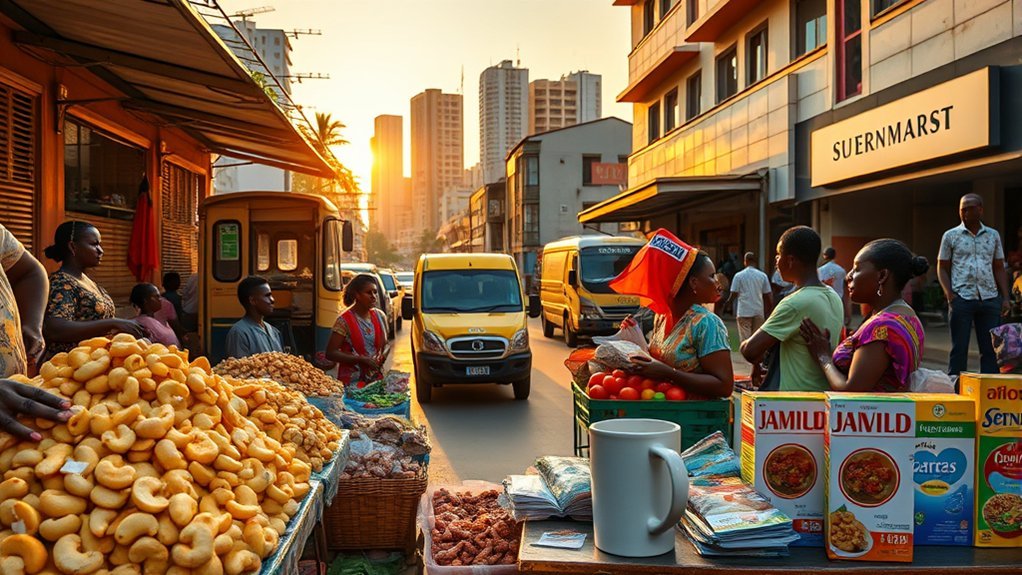
While Mozambique’s overall monthly cost of living—about $923—is roughly 2.8 times lower than in the United States, that aggregate masks where savings are greatest and where policy gaps matter: you’ll see the biggest differences in housing, food, and transport.
A 1-bedroom apartment in city centers averages $462.89 in Mozambique versus $1,664.59 in the U.S., signaling major urban housing affordability advantages but also varying quality and infrastructure.
Dining out and groceries are substantially cheaper (basic meal $6.85 vs $19.45; loaf of bread $0.77 vs $3.56), which lowers everyday budgets but reflects supply chain and productivity differences.
Public transit costs are far lower ($13.16 monthly vs $65.85), reducing commuting burdens if services are reliable.
When comparing to other countries, weigh public services, safety nets, and housing regulation: lower nominal cost of living can coexist with weaker public healthcare, education funding, and labor protections, factors you should assess alongside price comparisons.
Frequently Asked Questions
Is Mozambique Cheap or Expensive?
Mozambique’s generally cheap compared to global averages; you’ll pay roughly $923 monthly, with low housing, transport, and dining costs, so you can plan policy or budgets assuming affordability, though regional and income disparities persist.
Is Mozambique a Good Country to Live In?
Coincidentally, you’ll find Mozambique’s affordability and lower housing costs make it a viable choice; you’ll need careful budgeting given modest wages, limited services, and policy gaps, so it’s suitable if you plan around those constraints.
How Much Is the Average House in Mozambique?
The average house price varies, but a 1‑bedroom city center rent is about $467 monthly and a 3‑bedroom averages $861; apartment purchase prices near $4,856 per m², so you’ll find much lower costs than in developed countries.
How Much Is the Average Salary in Mozambique?
Guess what can you do with $384 a month? You’re earning about $384 (≈27,917 MT) net on average, which falls far short of needs, informing policy priorities for wages, social safety nets, and economic reforms.
Conclusion
You’ll find Mozambique’s modest monthly musts—rent, repairs, reliable rides—are markedly more manageable than many Western markets, but variable. Use detailed data to drive decisions: prioritize policy-aware planning for public services, plan for private healthcare and schooling where state provision’s sparse, and factor in fluctuating fuel and food prices. Strategic spending and smart savings can secure stable standards; sound, scalable solutions support sustainable, socio-economic success across seasons.

